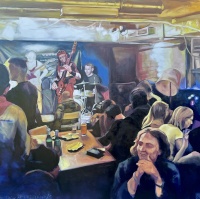Takáts, Márton Jaco Pastorius in the "Lampas" club

Current auction
In case of questions please ask:
Details
Description
Márton Takáts completed his studies in printmaking at the Academy of Fine Arts, then continued in the master school of the same institution, where Róbert Kőnig was his teacher throughout.
His meticulously crafted works, reflecting great precision, testify to his respect for artistic tradition. His cheerful, bohemian-spirited graphics and paintings are imaginative, forming an intriguing blend of reality and imagination, and of past, present, and future. His images feature cities—Rome–Paris–Budapest (the title of one of his exhibitions)—as well as everyday streets, bridges, Metro Line 4 (one of his series), fantastic landscapes (the Eastern Landscapes series), his native village Pilisborosjenő, or even Budapest coffee houses.
In his oil painting Jacko by the Lamp, we also see the interior of a café or bar, filled to the brim. People sit at the tables talking, drinking beer, paying no attention to what is happening at the center of the composition. Here John Francis Pastorius—known professionally as Jaco Pastorius—bass guitarist and composer, is playing with his band for the audience, if indeed that is what we are seeing.
Jaco Pastorius, renowned for his virtuoso technique and playing style, had a short but intense career. His distinctive sound—operating within the genres of fusion jazz, funk, and jazz-rock—made him a role model for generations. He was an extremely charismatic musician, full of self-confidence, yet destined for a tragic fate.
Thus, he stands at the center of Jacko by the Lamp. What makes the work particularly interesting is that Jaco and his band can be interpreted both as a picture and as reality. The composition hanging on the back wall appears as if it were a stage set. The lamp mentioned in the title does not shine; its tilted shade stands in real space.
The hyperrealistic style and vivid colors of the painting vividly convey the atmosphere of places where conversations, scents, and sounds take precedence—where music connects the participants even more deeply, allowing them to dissolve into the experience of togetherness.



